

Fisheries Behavioral Ecology - Program Facilities
State-of-the-art rearing systems and experimental facilities developed by the Fisheries Behavioral Ecology Program over a 20-year period at the Hatfield Marine Science Center make it possible to study all life stages, from egg to adult, with selectively controlled combinations of physical and biological factors.
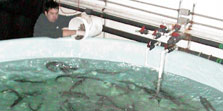 |
Rearing Systems
Fish for Program research are held in 4 buildings and 10 different rooms for culture, grow-out, and maintenance. These facilities have controlled photoperiods and are supplied with temperature-controlled flow-through seawater. Foods including algae, rotifers, and copepods are also cultured. |
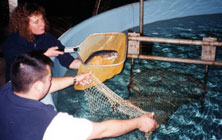 |
Experimental Systems
Experiments are conducted in three buildings holding almost 100 tanks of different dimensions for work with fish ranging in size from larvae to large sablefish and halibut. All have controlled light and temperature, and most are equipped with video systems. |
Behavioral responses of fishes to external stimuli can be monitored 24 hours per day by video-recording systems using low light and infra-red video cameras (for work in total darkness). Specially designed tanks have been developed to simulate fish-capturing processes.
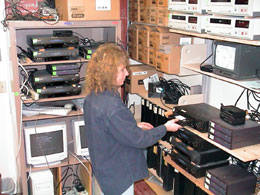 |
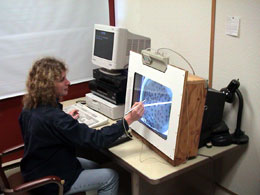 |
The video lab houses VCRs, monitors, and time/date generators for timed recordings of fish behavior. |
Digitizing movements of fish from video recordings. The digitizer allows one to calculate swim speeds for individual fish and nearest neighbor distances. |
Filtered seawater (to 350 GPM) is supplied to holding tanks and experimental systems in several buildings on a continuous, flow-through basis. Systems have been designed to duplicate natural patterns of light and temperature, simulate daily changes in light intensity, and form vertical thermal gradients. Temperature control capabilities allow experiments to be conducted at temperatures as low as 0ºC. Water treatment facilities allow holding for fishes under quarantine for disease (as required for fish transported from out of state) with flows up to 180 GPM.
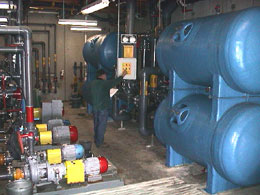 |
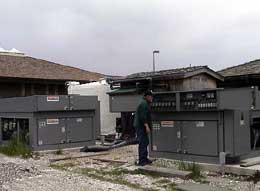 |
Four centralized sand filters with a total capability of 1,222 GPM supply seawater to the laboratories at the Hatfield Marine Science Center. |
Two centralized 100 ton chiller units and a 6,000 gallon glycol reservoir are capable of producing seawater to 2 degree Celsius at 150 gallons per minute for the Fisheries Behavioral Ecology Program. |
Last updated
27 March, 2009
|